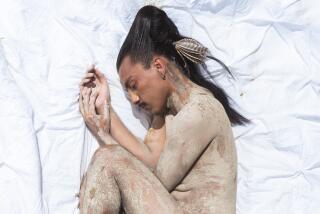Photos captured Marilyn Monroe in final weeks
- Share via
When Bert Stern photographed the world’s most photographed woman, he had a feeling that it would be a once-in-a-lifetime opportunity.
He was right.
Six weeks after their boozy sessions in a suite at the Hotel Bel-Air, Marilyn Monroe died of an apparent barbiturate overdose and Stern had more than 2,500 sexy, sweet, sad images that would constitute his best-known legacy.
Shooting for a 1962 fashion spread in Vogue, Stern stocked a trove of beads, paper flowers, chiffon scarves and, at the star’s request, Dom Perignon champagne. In photos from two sessions, Marilyn is both wide-eyed and heavy-lidded. At one point, she vamps for the camera in a garland of fake pearls, an ersatz birthmark and a Jackie Kennedy wig; at others, she’s elegantly present in a black Dior gown, a see-through veil or, exposing a scar from recent gallbladder surgery, nothing at all.
A photographer who broke new ground in advertising before he became famous for his evocative celebrity portraits, Stern, 83, died Wednesday at his New York City home of undisclosed causes. He had been undergoing neurological tests for several weeks, said his wife, Shannah Laumeister.
Stern published a book of images from what he called “The Last Sitting” in 1982. He reprised many of Monroe’s poses in a 2008 shoot, also at the Bel-Air, with Lindsay Lohan, an ardent fan of Monroe’s films.
“Stern excavated and preserved the poignant humanity of the real woman -- beautiful, but also fragile, needy, flawed,” a writer observed in New York magazine in 2008. “In our armored, airbrushed age, his achievement feels almost revolutionary.”
Born Oct. 3, 1929, in New York City, Stern dropped out of high school in Brooklyn and, at 18, wound up working in the mailroom at Look magazine. There, he became friends with staff photographer Stanley Kubrick.
Years later, after Kubrick had achieved fame as a Hollywood director, Stern designed and shot a poster for the 1962 film “Lolita,” with star Sue Lyon wearing heart-shaped sunglasses and sucking a lollipop.
Despite the studio’s intent to downplay the tender age -- 12 in the book, 16 in the film -- of Lolita as a middle-aged man’s love interest, Stern “couldn’t resist the temptation to be bad,” said Steven Heller, who writes for the Atlantic magazine’s website.
“While driving Lyon to the photo shoot, he serendipitously found the sunglasses in Woolworth’s, bought them, put them on Lyon and instantly had the perfect shot -- the studio be damned,” Heller wrote earlier this year.
Stern, who taught himself photography, displayed an iconoclastic streak early in his career.
After returning from Army service in Tokyo during the Korean War, he did a series of magazine ads for Smirnoff vodka. One showed a cocktail glass on the red sands before the Great Pyramid at Giza, with a tiny inverted pyramid shimmering in the vodka.”It was truly a breakthrough image,” said Bruce Barnes, director of the George Eastman House photography museum in Rochester, N.Y. “Until that time, most ads were illustrative of products or their benefits. Stern was moving into much more evocative, metaphysical imagery. It was a quantum leap over what had been done before.”
He applied the same philosophy to more down-to-earth products, including Noxzema skin cream and cans of Spam.
For years, Stern churned out trendy ads from a studio “not unlike Andy Warhol’s Factory,” according to a tribute in the Art Directors Club Hall of Fame. Stern “personified the commercial photographer as cultural hero,” the club said.
As advertising lore has it, Stern needed a small elephant for an ad and crammed one into an elevator at his studio on Manhattan’s West 40th Street. He recalled it differently.
“I seem to remember a camel,” he told the New York Times in 2004, “but that was another building.”
In his only motion picture venture, he directed “Jazz on a Summer’s Day,” an acclaimed 1959 documentary about the Newport Jazz Festival.
He was the subject of a 2010 documentary, “Bert Stern: Original Madman,” directed by Laumeister, who told The Times that she and Stern secretly married -- “for private reasons” -- in 2009.
He also is survived by three children from a previous marriage, daughters Trista and Susannah, and son Bret; his sister, Diane Schlanger; and three grandchildren.
Stern did portraits of many celebrities, including Brigitte Bardot, Sophia Loren, Audrey Hepburn and Twiggy.
“Women are everything,” he said in the documentary about his life’s work. “Man is just a muscle.”
--







